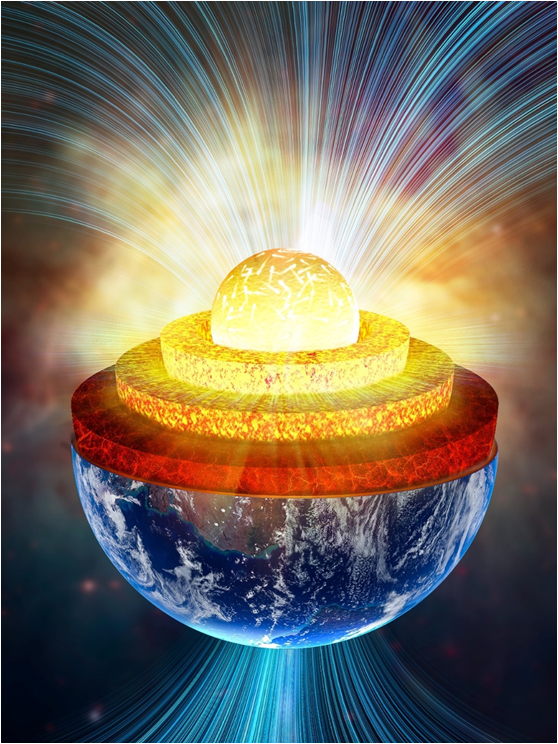Earth's inner core: a mixture of solid Fe and liquid-like light elements - Dr. Duckyoung Kim
FEBRUARY 10, 2022
Over the past several decades, it's widely thought that the Earth's inner core is solid composed of iron alloy, but a team of scientists led by Center for High Pressure Science and Technology Advance Research (HPSTAR) and Institute of Geochemistry of CAS (GYIG) suggests that the inner core is not a conventionally known solid but a mixture of solid iron and light-element fluids. Their findings are published February 10 in Nature.
The Earth we live on has been around 4.6 billion years since its formation. However, our knowledge is very limited especially about its inner core because no one can access to this depth, ~5000 kilometers beneath our feet. Instead we can learn about it through laboratory experiments, theoretical simulation, and seismology observation indirectly.
In 1936, the earth's inner core was detected for the first time from seismological observations. Based on the seismic waves which travel through the whole Earth, basic understanding of the core — liquid outer core and solid inner core of compressed iron is established. Later seismology also show that the density of the Earth's inner core is always lower than that of pure iron, thus some light elements such as hydrogen, carbon, and oxygen were proposed to exist in the Earth's core. For these potential light elements, a lot of research has been done to constrain the composition of the Earth's inner core. However, the state of the light elements involved remains unknown at all.
In order to address this question, the research team includes HPSTAR scientists Drs. Duck Young Kim, Bo Gyu Jang, and Ho-Kwang Mao and GYIG scientists Drs. Yu He, Shichuan Sun, and Heping Li modeled the properties of various iron alloys under Earth's inner core conditions from molecular dynamics simulations and found that Fe-H, Fe-C and Fe-O alloys would transform to a superionic state under the inner core temperature and pressure conditions. Therefore they proposed that the earth's core might be in a superionic state composed of solid iron and highly diffusive light elements.

Caption: Earth’s interior structure and superionic inner core.
Superionic state is an intermediate state between solid and liquid, which is thought to exist widely in the interior of Earth and planets. Using high-pressure and high-temperature simulations based on quantum mechanics theory, they found that Fe-H, Fe-C, and Fe-O alloys transformed to superionic states under inner core conditions — light elements become disordered and diffuse like liquid in the lattice, while iron atoms remain ordered and vibrate harmonically near their lattice point, forming the solid iron framework.
“One long-standing mystery is that the seismological observation shows the inner core is quite “soft” — quite low shear wave velocity. Based on the results of our calculations on the seismic velocities in these superionic iron alloys, we could predict a significant decrease in shear wave velocity which agrees well with seismological observations. It is the liquid-like elements make the inner core soften,” explained by Dr. Kim.
“Highly diffusive light elements have a significant effect on seismic velocities, which provides critical clues in understanding other mysteries in the inner core. The anisotropic structure, seismic wave attenuations, and structural changes of the inner core during past decades can be rationalized in the superionic model by considering the distribution and convection of these liquid-like elements in the inner core. This makes the superionic inner core a new standing point for future studies,” Dr. Kim added.
地震波数据显示地球内核的密度比纯铁低,因而人们推测地球内核中可能存在氢、碳、氧等轻元素。对于这些潜在的轻元素,前人做了大量的研究以确定地球内核的组成。然而,这些轻元素在内核中的存在状态却很少被关注到。近期,北京高压科学中心的Duck Young Kim研究员团队与中国科学院地球化学研究所的何宇研究员团队合作,利用分子动力学模拟,在地球内核的温度和压力条件下,对多种铁合金的性质进行了模拟计算。他们发现Fe-H,Fe-C和Fe-O合金在内核温压条件下会转变成为了超离子态,因而提出地球内可能是由固态铁和流动的轻元素组成的超离子态—该发现颠覆了过去半个多世纪以来人们对地球内核的认知。相关工作以“Superionic hcp-Fe alloys and their seismic velocities in Earth's inner core”为题于2022年2月10日发表在Nature期刊。
